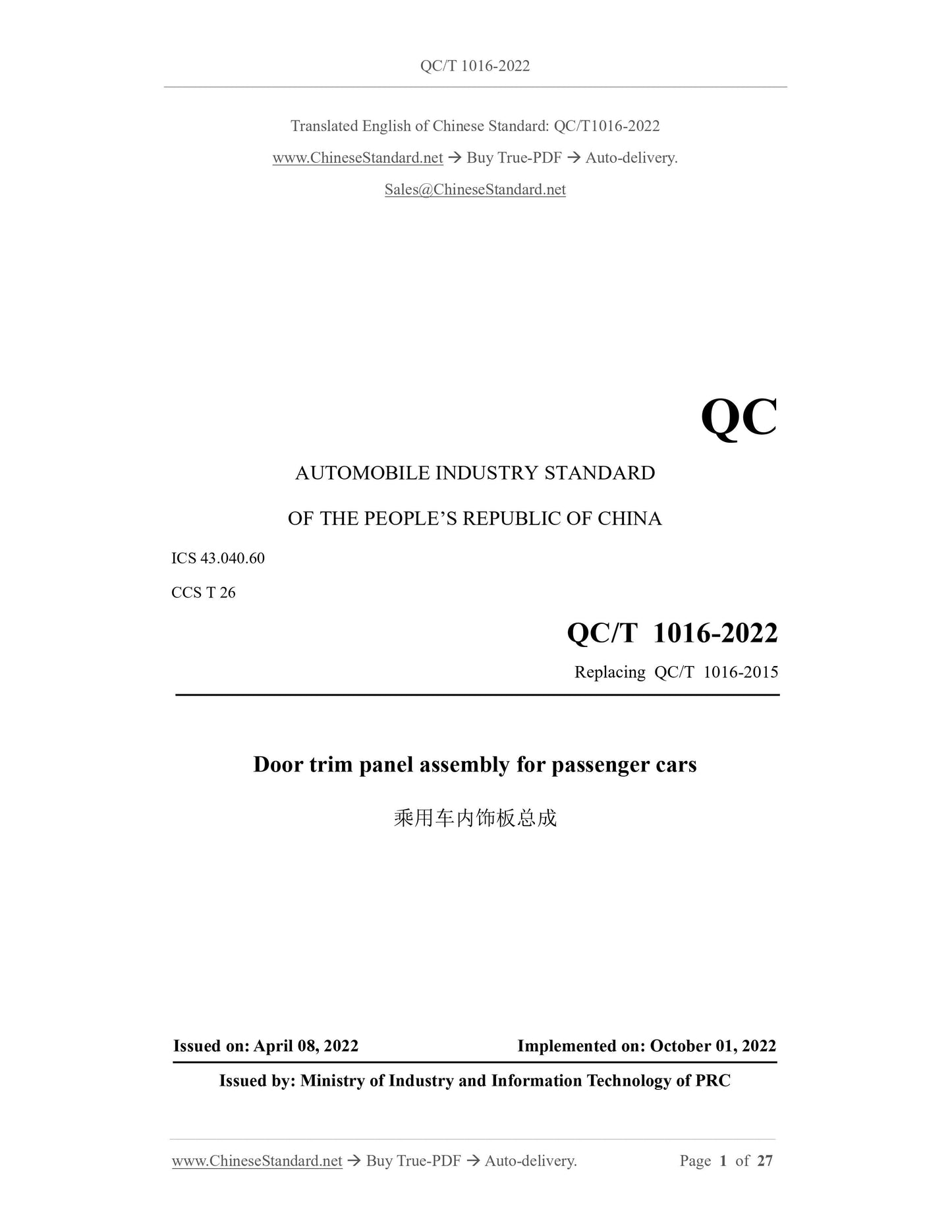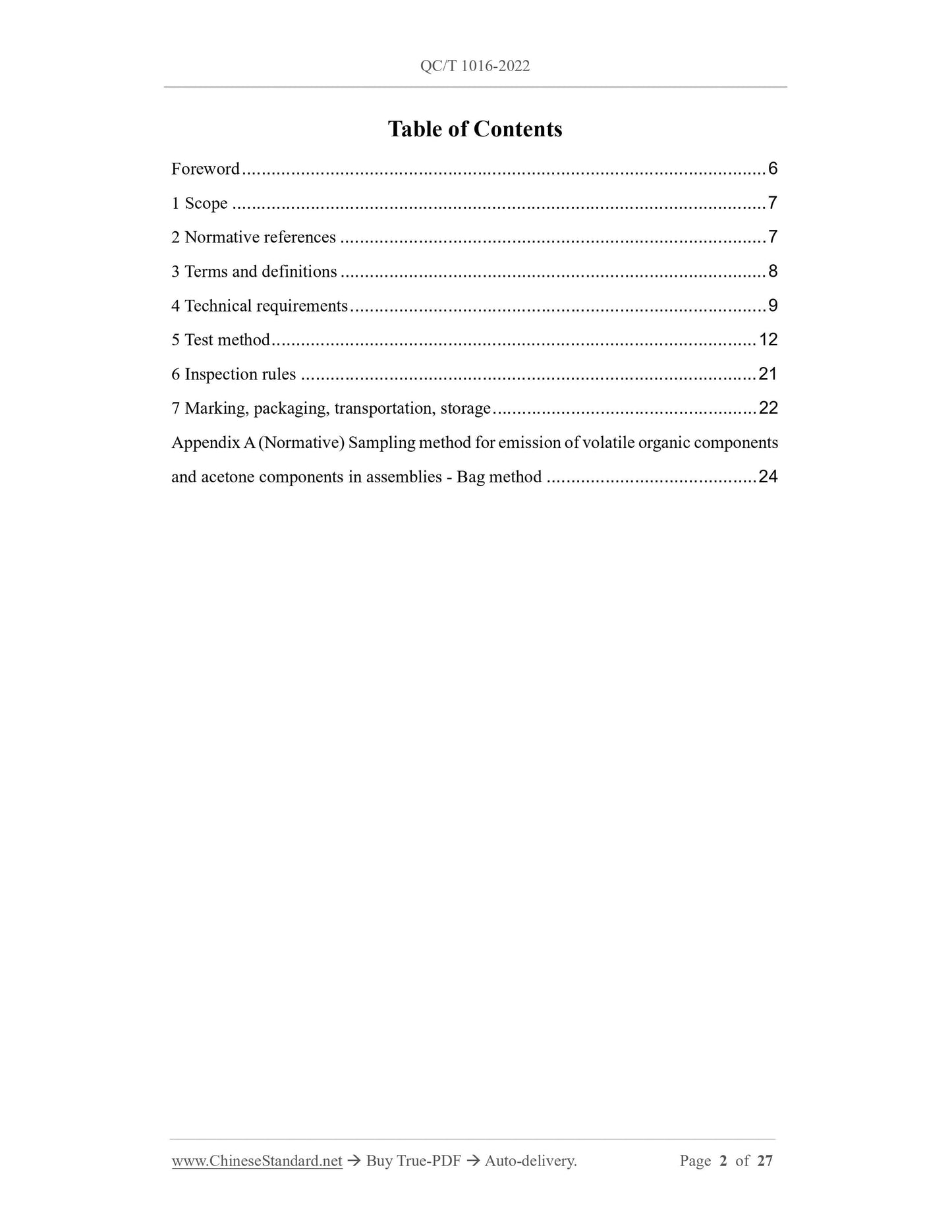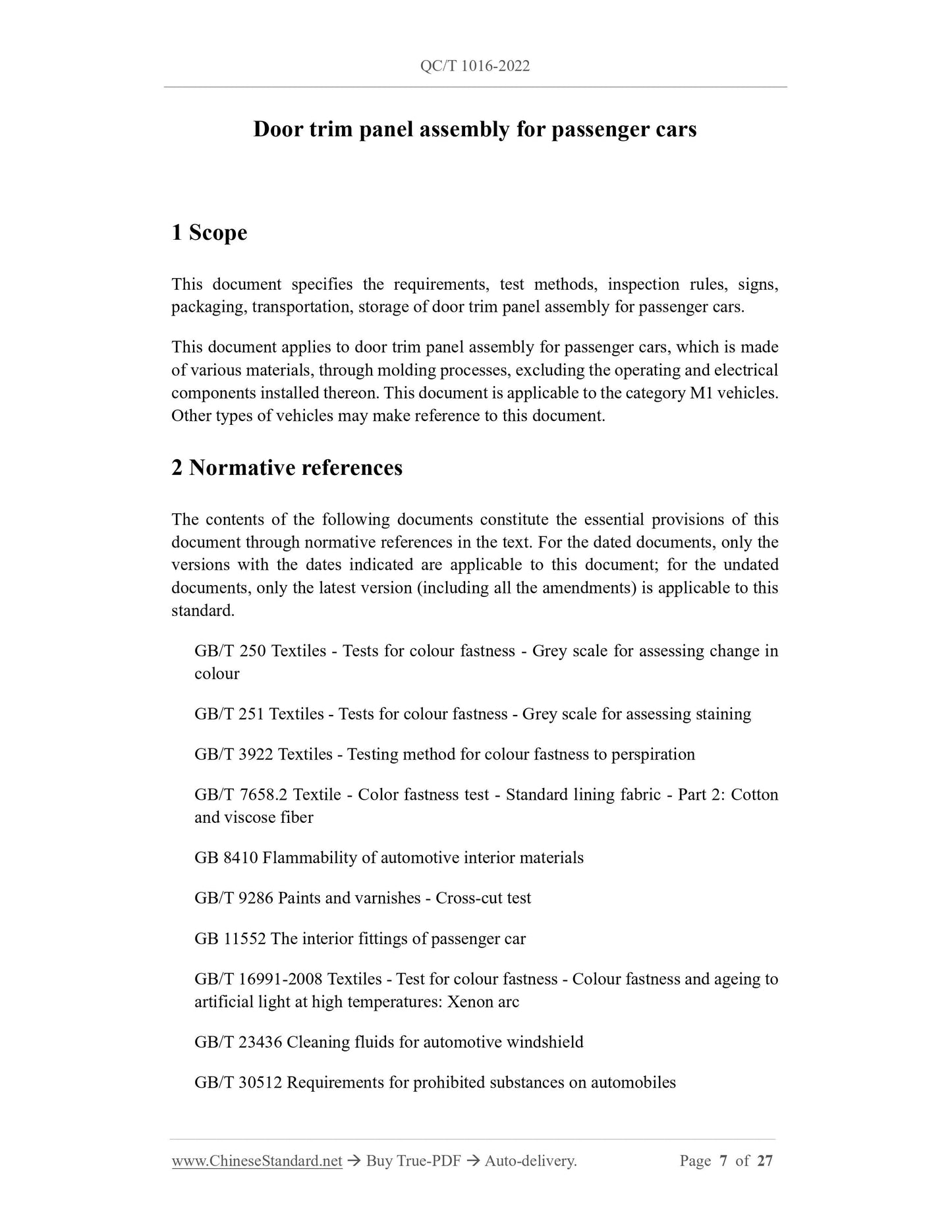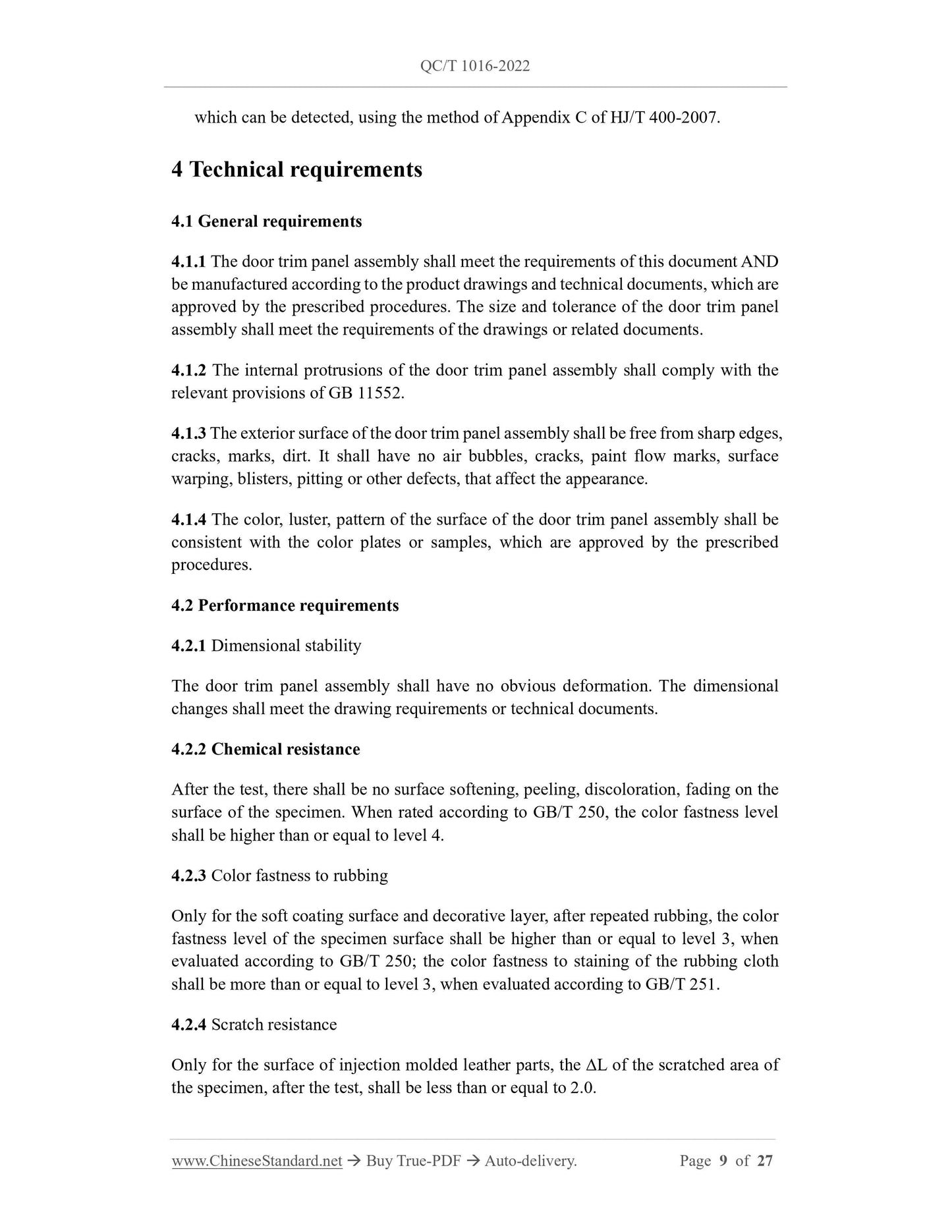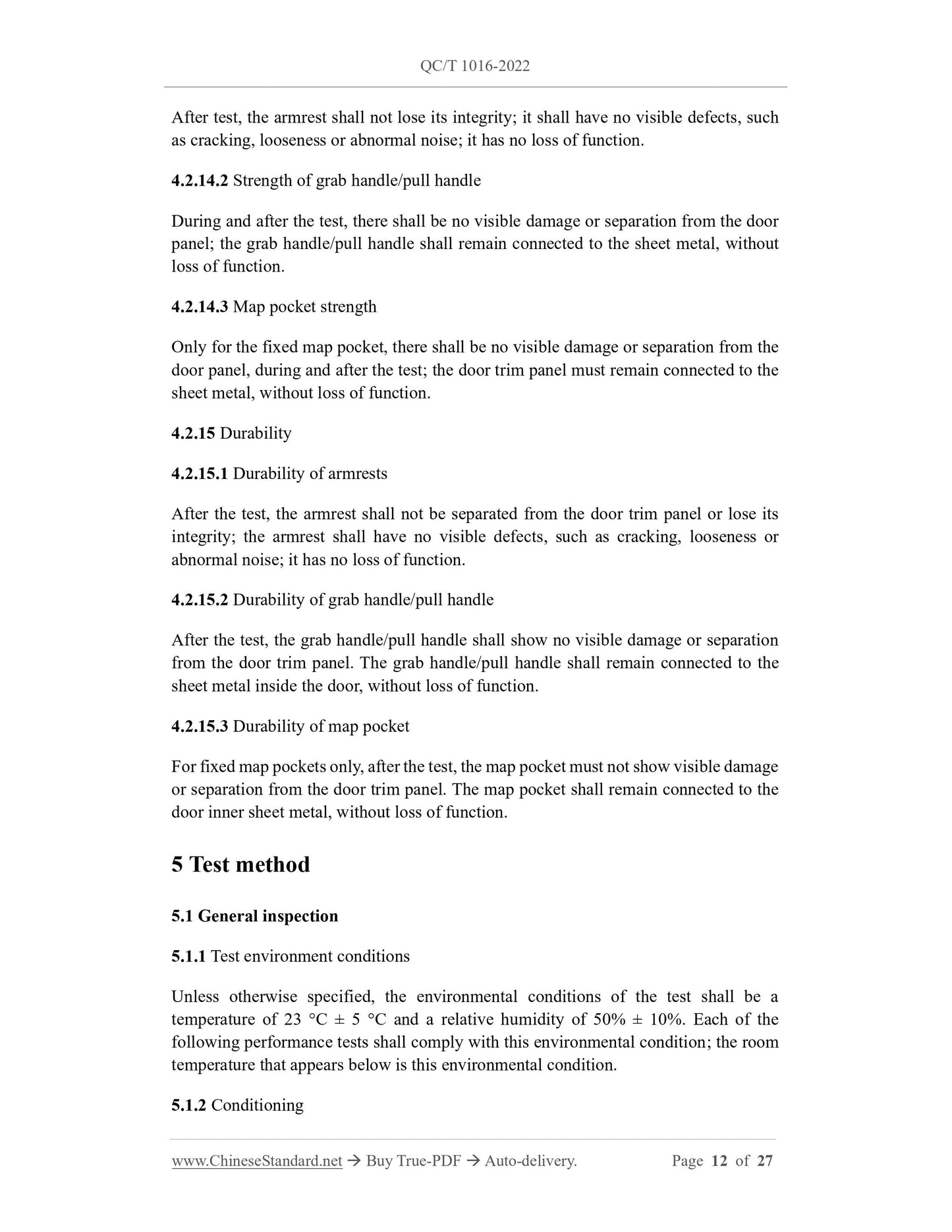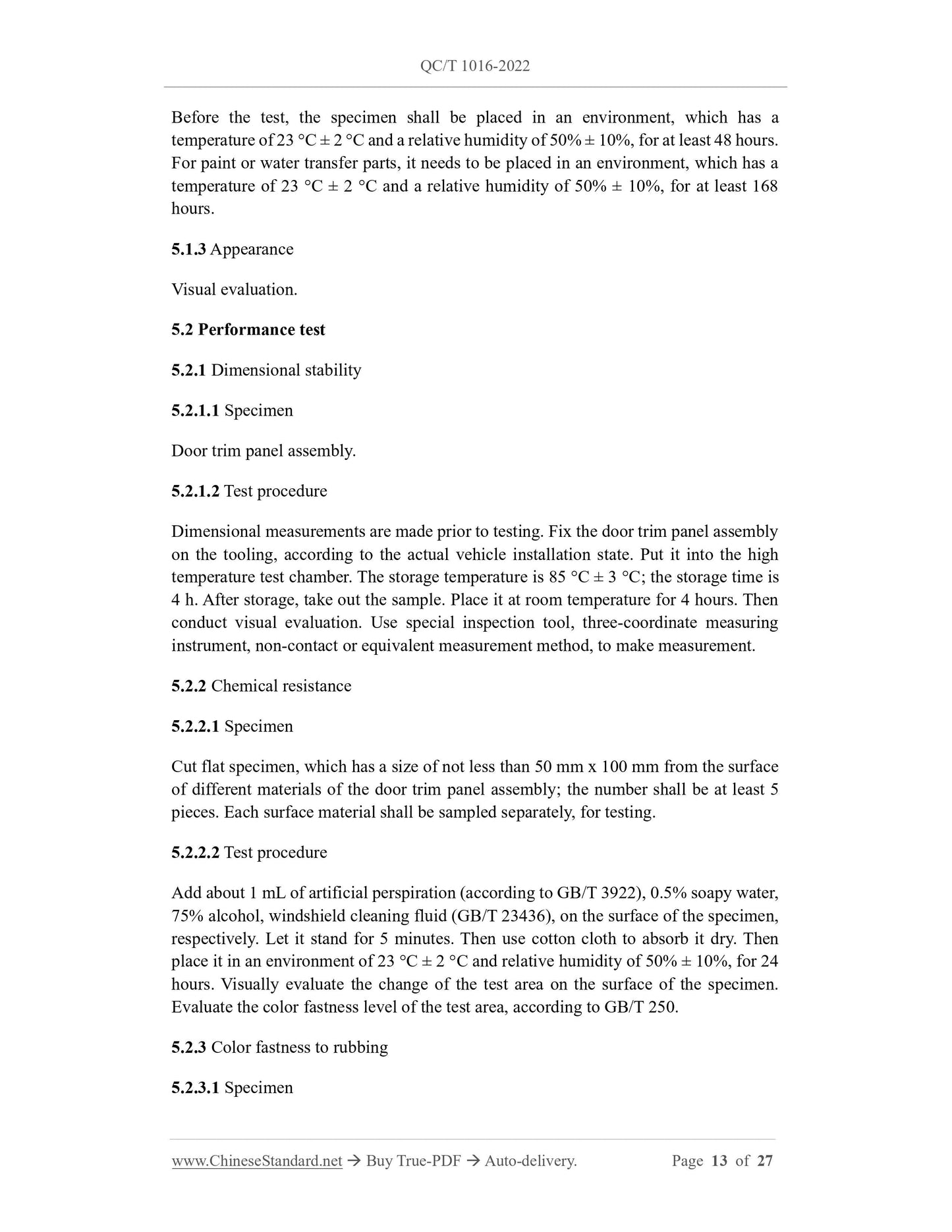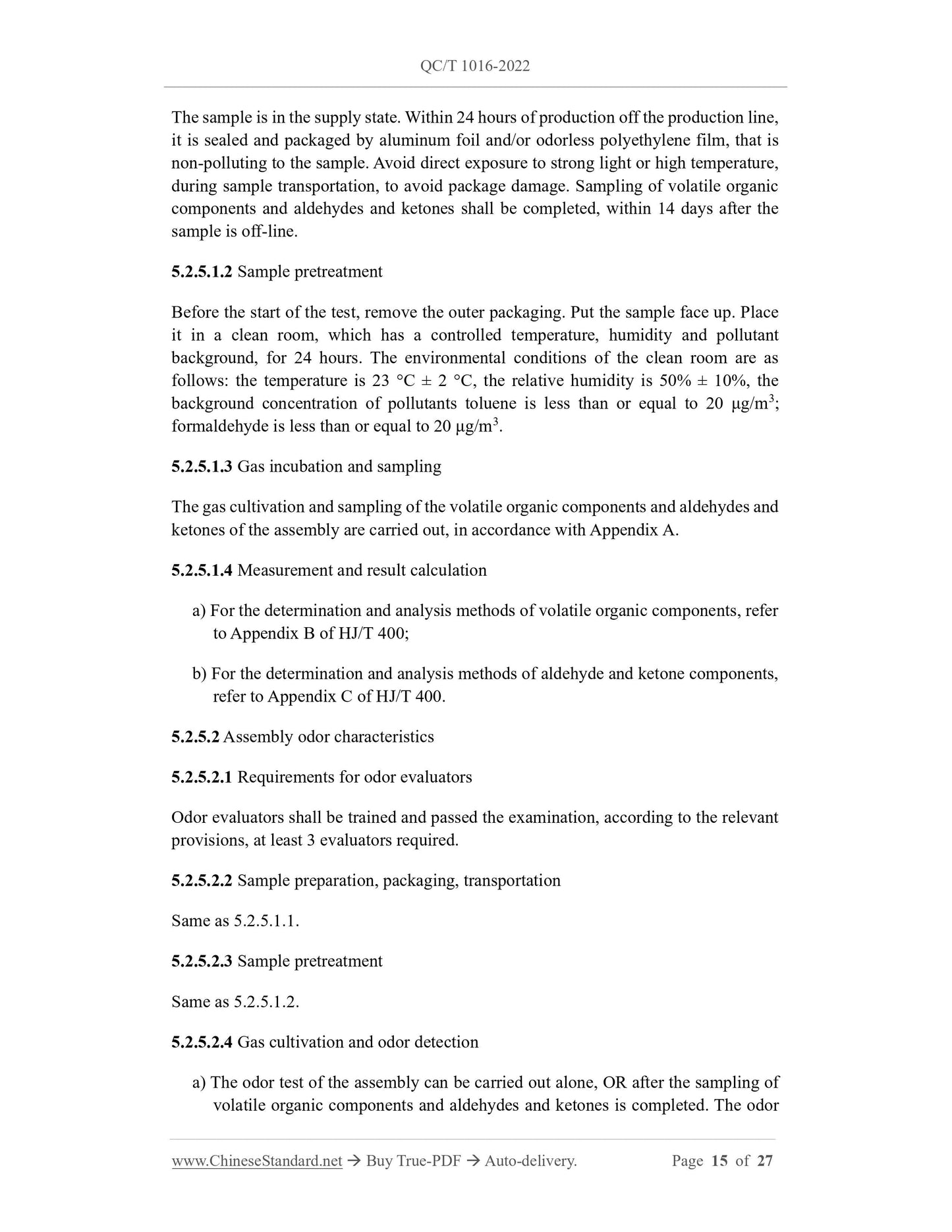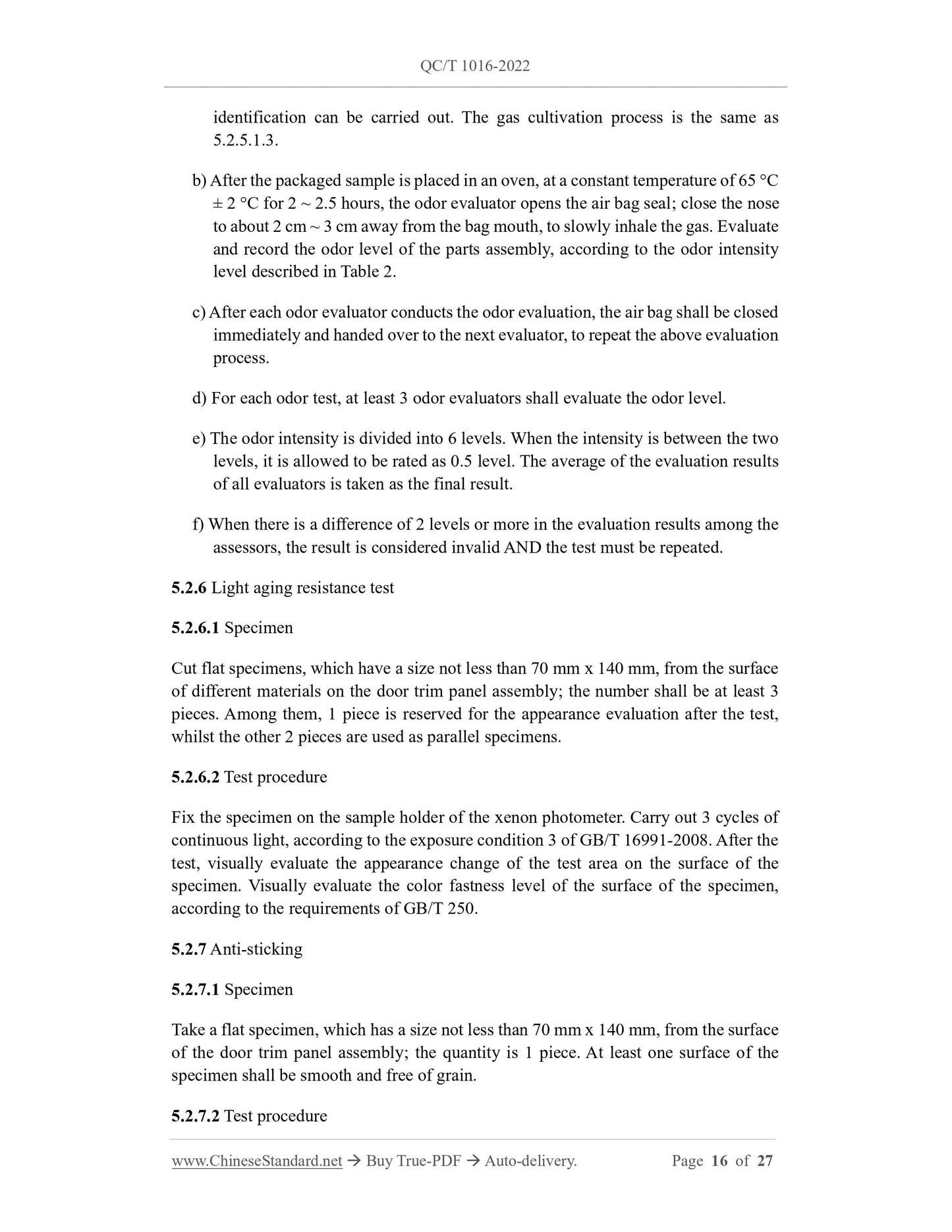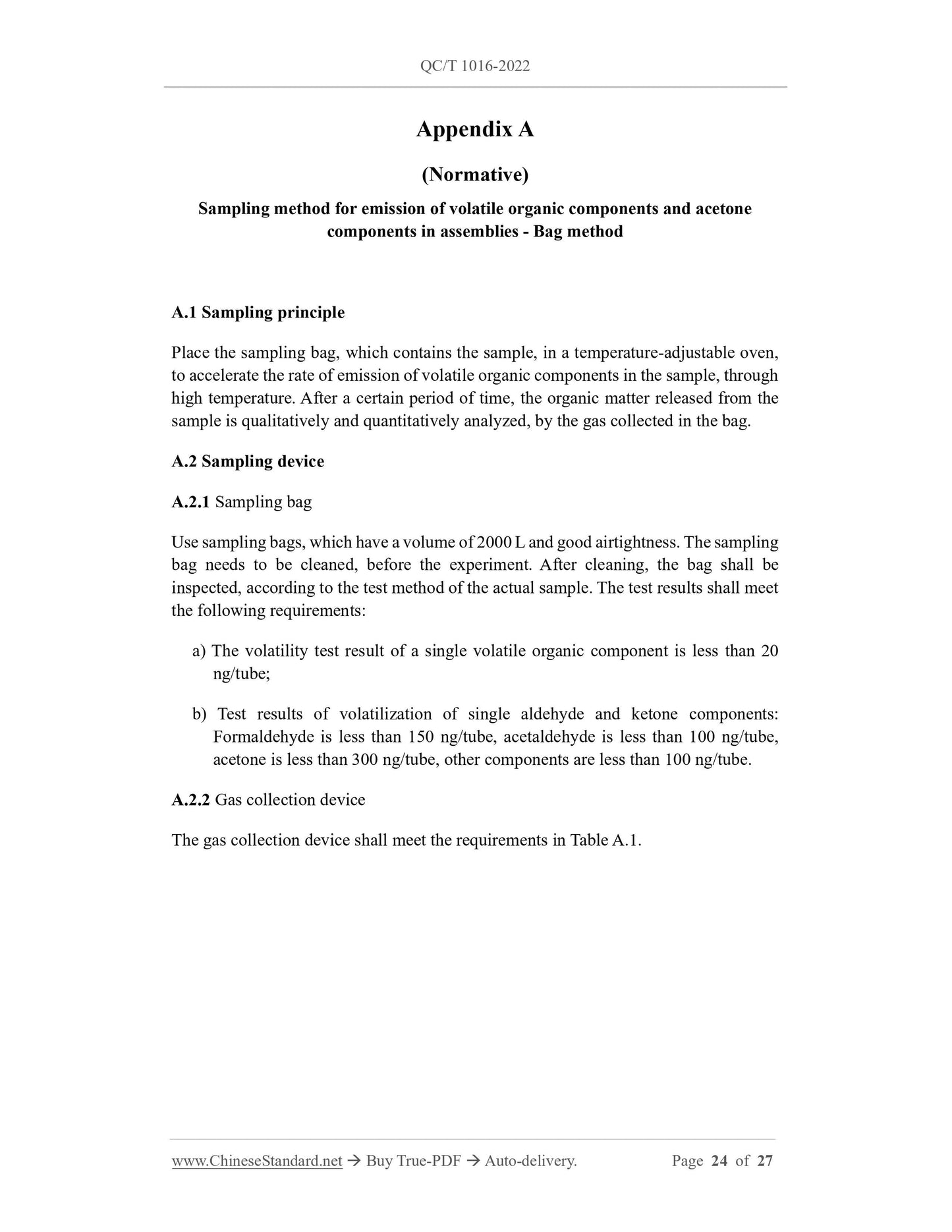1
/
of
9
PayPal, credit cards. Download editable-PDF & invoice in 1 second!
QC/T 1016-2022 English PDF (QCT1016-2022)
QC/T 1016-2022 English PDF (QCT1016-2022)
Regular price
$260.00 USD
Regular price
Sale price
$260.00 USD
Unit price
/
per
Shipping calculated at checkout.
Couldn't load pickup availability
Delivery: 3 seconds. Download true-PDF + Invoice.
Get QUOTATION in 1-minute: Click QC/T 1016-2022
Historical versions: QC/T 1016-2022
Preview True-PDF (Reload/Scroll if blank)
QC/T 1016-2022: Door trim panel assembly for passenger cars
QC/T 1016-2022
QC
AUTOMOBILE INDUSTRY STANDARD
OF THE PEOPLE’S REPUBLIC OF CHINA
ICS 43.040.60
CCS T 26
Replacing QC/T 1016-2015
Door trim panel assembly for passenger cars
ISSUED ON: APRIL 08, 2022
IMPLEMENTED ON: OCTOBER 01, 2022
Issued by: Ministry of Industry and Information Technology of PRC
Table of Contents
Foreword ... 6
1 Scope ... 7
2 Normative references ... 7
3 Terms and definitions ... 8
4 Technical requirements ... 9
5 Test method ... 12
6 Inspection rules ... 21
7 Marking, packaging, transportation, storage ... 22
Appendix A (Normative) Sampling method for emission of volatile organic components
and acetone components in assemblies - Bag method ... 24
Door trim panel assembly for passenger cars
1 Scope
This document specifies the requirements, test methods, inspection rules, signs,
packaging, transportation, storage of door trim panel assembly for passenger cars.
This document applies to door trim panel assembly for passenger cars, which is made
of various materials, through molding processes, excluding the operating and electrical
components installed thereon. This document is applicable to the category M1 vehicles.
Other types of vehicles may make reference to this document.
2 Normative references
The contents of the following documents constitute the essential provisions of this
document through normative references in the text. For the dated documents, only the
versions with the dates indicated are applicable to this document; for the undated
documents, only the latest version (including all the amendments) is applicable to this
standard.
GB/T 250 Textiles - Tests for colour fastness - Grey scale for assessing change in
colour
GB/T 251 Textiles - Tests for colour fastness - Grey scale for assessing staining
GB/T 3922 Textiles - Testing method for colour fastness to perspiration
GB/T 7658.2 Textile - Color fastness test - Standard lining fabric - Part 2: Cotton
and viscose fiber
GB 8410 Flammability of automotive interior materials
GB/T 9286 Paints and varnishes - Cross-cut test
GB 11552 The interior fittings of passenger car
GB/T 16991-2008 Textiles - Test for colour fastness - Colour fastness and ageing to
artificial light at high temperatures: Xenon arc
GB/T 23436 Cleaning fluids for automotive windshield
GB/T 30512 Requirements for prohibited substances on automobiles
which can be detected, using the method of Appendix C of HJ/T 400-2007.
4 Technical requirements
4.1 General requirements
4.1.1 The door trim panel assembly shall meet the requirements of this document AND
be manufactured according to the product drawings and technical documents, which are
approved by the prescribed procedures. The size and tolerance of the door trim panel
assembly shall meet the requirements of the drawings or related documents.
4.1.2 The internal protrusions of the door trim panel assembly shall comply with the
relevant provisions of GB 11552.
4.1.3 The exterior surface of the door trim panel assembly shall be free from sharp edges,
cracks, marks, dirt. It shall have no air bubbles, cracks, paint flow marks, surface
warping, blisters, pitting or other defects, that affect the appearance.
4.1.4 The color, luster, pattern of the surface of the door trim panel assembly shall be
consistent with the color plates or samples, which are approved by the prescribed
procedures.
4.2 Performance requirements
4.2.1 Dimensional stability
The door trim panel assembly shall have no obvious deformation. The dimensional
changes shall meet the drawing requirements or technical documents.
4.2.2 Chemical resistance
After the test, there shall be no surface softening, peeling, discoloration, fading on the
surface of the specimen. When rated according to GB/T 250, the color fastness level
shall be higher than or equal to level 4.
4.2.3 Color fastness to rubbing
Only for the soft coating surface and decorative layer, after repeated rubbing, the color
fastness level of the specimen surface shall be higher than or equal to level 3, when
evaluated according to GB/T 250; the color fastness to staining of the rubbing cloth
shall be more than or equal to level 3, when evaluated according to GB/T 251.
4.2.4 Scratch resistance
Only for the surface of injection molded leather parts, the ΔL of the scratched area of
the specimen, after the test, shall be less than or equal to 2.0.
After test, the armrest shall not lose its integrity; it shall have no visible defects, such
as cracking, looseness or abnormal noise; it has no loss of function.
4.2.14.2 Strength of grab handle/pull handle
During and after the test, there shall be no visible damage or separation from the door
panel; the grab handle/pull handle shall remain connected to the sheet metal, without
loss of function.
4.2.14.3 Map pocket strength
Only for the fixed map pocket, there shall be no visible damage or separation from the
door panel, during and after the test; the door trim panel must remain connected to the
sheet metal, without loss of function.
4.2.15 Durability
4.2.15.1 Durability of armrests
After the test, the armrest shall not be separated from the door trim panel or lose its
integrity; the armrest shall have no visible defects, such as cracking, looseness or
abnormal noise; it has no loss of function.
4.2.15.2 Durability of grab handle/pull handle
After the test, the grab handle/pull handle shall show no visible damage or separation
from the door trim panel. The grab handle/pull handle shall remain connected to the
sheet metal inside the door, without loss of function.
4.2.15.3 Durability of map pocket
For fixed map pockets only, after the test, the map pocket must not show visible damage
or separation from the door trim panel. The map pocket shall remain connected to the
door inner sheet metal, without loss of function.
5 Test method
5.1 General inspection
5.1.1 Test environment conditions
Unless otherwise specified, the environmental conditions of the test shall be a
temperature of 23 °C ± 5 °C and a relative humidity of 50% ± 10%. Each of the
following performance tests shall comply with this environmental condition; the room
temperature that appears below is this environmental condition.
5.1.2 Conditioning
Before the test, the specimen shall be placed in an environment, which has a
temperature of 23 °C ± 2 °C and a relative humidity of 50% ± 10%, for at least 48 hours.
For paint or water transfer parts, it needs to be placed in an environment, which has a
temperature of 23 °C ± 2 °C and a relative humidity of 50% ± 10%, for at least 168
hours.
5.1.3 Appearance
Visual evaluation.
5.2 Performance test
5.2.1 Dimensional stability
5.2.1.1 Specimen
Door trim panel assembly.
5.2.1.2 Test procedure
Dimensional measurements are made prior to testing. Fix the door trim panel assembly
on the tooling, according to the actual vehicle installation state. Put it into the high
temperature test chamber. The storage temperature is 85 °C ± 3 °C; the storage time is
4 h. After storage, take out the sample. Place it at room temperature for 4 hours. Then
conduct visual evaluation. Use special inspection tool, three-coordinate measuring
instrument, non-contact or equivalent measurement method, to make measurement.
5.2.2 Chemical resistance
5.2.2.1 Specimen
Cut flat specimen, which has a size of not less than 50 mm x 100 mm from the surface
of different materials of the door trim...
Get QUOTATION in 1-minute: Click QC/T 1016-2022
Historical versions: QC/T 1016-2022
Preview True-PDF (Reload/Scroll if blank)
QC/T 1016-2022: Door trim panel assembly for passenger cars
QC/T 1016-2022
QC
AUTOMOBILE INDUSTRY STANDARD
OF THE PEOPLE’S REPUBLIC OF CHINA
ICS 43.040.60
CCS T 26
Replacing QC/T 1016-2015
Door trim panel assembly for passenger cars
ISSUED ON: APRIL 08, 2022
IMPLEMENTED ON: OCTOBER 01, 2022
Issued by: Ministry of Industry and Information Technology of PRC
Table of Contents
Foreword ... 6
1 Scope ... 7
2 Normative references ... 7
3 Terms and definitions ... 8
4 Technical requirements ... 9
5 Test method ... 12
6 Inspection rules ... 21
7 Marking, packaging, transportation, storage ... 22
Appendix A (Normative) Sampling method for emission of volatile organic components
and acetone components in assemblies - Bag method ... 24
Door trim panel assembly for passenger cars
1 Scope
This document specifies the requirements, test methods, inspection rules, signs,
packaging, transportation, storage of door trim panel assembly for passenger cars.
This document applies to door trim panel assembly for passenger cars, which is made
of various materials, through molding processes, excluding the operating and electrical
components installed thereon. This document is applicable to the category M1 vehicles.
Other types of vehicles may make reference to this document.
2 Normative references
The contents of the following documents constitute the essential provisions of this
document through normative references in the text. For the dated documents, only the
versions with the dates indicated are applicable to this document; for the undated
documents, only the latest version (including all the amendments) is applicable to this
standard.
GB/T 250 Textiles - Tests for colour fastness - Grey scale for assessing change in
colour
GB/T 251 Textiles - Tests for colour fastness - Grey scale for assessing staining
GB/T 3922 Textiles - Testing method for colour fastness to perspiration
GB/T 7658.2 Textile - Color fastness test - Standard lining fabric - Part 2: Cotton
and viscose fiber
GB 8410 Flammability of automotive interior materials
GB/T 9286 Paints and varnishes - Cross-cut test
GB 11552 The interior fittings of passenger car
GB/T 16991-2008 Textiles - Test for colour fastness - Colour fastness and ageing to
artificial light at high temperatures: Xenon arc
GB/T 23436 Cleaning fluids for automotive windshield
GB/T 30512 Requirements for prohibited substances on automobiles
which can be detected, using the method of Appendix C of HJ/T 400-2007.
4 Technical requirements
4.1 General requirements
4.1.1 The door trim panel assembly shall meet the requirements of this document AND
be manufactured according to the product drawings and technical documents, which are
approved by the prescribed procedures. The size and tolerance of the door trim panel
assembly shall meet the requirements of the drawings or related documents.
4.1.2 The internal protrusions of the door trim panel assembly shall comply with the
relevant provisions of GB 11552.
4.1.3 The exterior surface of the door trim panel assembly shall be free from sharp edges,
cracks, marks, dirt. It shall have no air bubbles, cracks, paint flow marks, surface
warping, blisters, pitting or other defects, that affect the appearance.
4.1.4 The color, luster, pattern of the surface of the door trim panel assembly shall be
consistent with the color plates or samples, which are approved by the prescribed
procedures.
4.2 Performance requirements
4.2.1 Dimensional stability
The door trim panel assembly shall have no obvious deformation. The dimensional
changes shall meet the drawing requirements or technical documents.
4.2.2 Chemical resistance
After the test, there shall be no surface softening, peeling, discoloration, fading on the
surface of the specimen. When rated according to GB/T 250, the color fastness level
shall be higher than or equal to level 4.
4.2.3 Color fastness to rubbing
Only for the soft coating surface and decorative layer, after repeated rubbing, the color
fastness level of the specimen surface shall be higher than or equal to level 3, when
evaluated according to GB/T 250; the color fastness to staining of the rubbing cloth
shall be more than or equal to level 3, when evaluated according to GB/T 251.
4.2.4 Scratch resistance
Only for the surface of injection molded leather parts, the ΔL of the scratched area of
the specimen, after the test, shall be less than or equal to 2.0.
After test, the armrest shall not lose its integrity; it shall have no visible defects, such
as cracking, looseness or abnormal noise; it has no loss of function.
4.2.14.2 Strength of grab handle/pull handle
During and after the test, there shall be no visible damage or separation from the door
panel; the grab handle/pull handle shall remain connected to the sheet metal, without
loss of function.
4.2.14.3 Map pocket strength
Only for the fixed map pocket, there shall be no visible damage or separation from the
door panel, during and after the test; the door trim panel must remain connected to the
sheet metal, without loss of function.
4.2.15 Durability
4.2.15.1 Durability of armrests
After the test, the armrest shall not be separated from the door trim panel or lose its
integrity; the armrest shall have no visible defects, such as cracking, looseness or
abnormal noise; it has no loss of function.
4.2.15.2 Durability of grab handle/pull handle
After the test, the grab handle/pull handle shall show no visible damage or separation
from the door trim panel. The grab handle/pull handle shall remain connected to the
sheet metal inside the door, without loss of function.
4.2.15.3 Durability of map pocket
For fixed map pockets only, after the test, the map pocket must not show visible damage
or separation from the door trim panel. The map pocket shall remain connected to the
door inner sheet metal, without loss of function.
5 Test method
5.1 General inspection
5.1.1 Test environment conditions
Unless otherwise specified, the environmental conditions of the test shall be a
temperature of 23 °C ± 5 °C and a relative humidity of 50% ± 10%. Each of the
following performance tests shall comply with this environmental condition; the room
temperature that appears below is this environmental condition.
5.1.2 Conditioning
Before the test, the specimen shall be placed in an environment, which has a
temperature of 23 °C ± 2 °C and a relative humidity of 50% ± 10%, for at least 48 hours.
For paint or water transfer parts, it needs to be placed in an environment, which has a
temperature of 23 °C ± 2 °C and a relative humidity of 50% ± 10%, for at least 168
hours.
5.1.3 Appearance
Visual evaluation.
5.2 Performance test
5.2.1 Dimensional stability
5.2.1.1 Specimen
Door trim panel assembly.
5.2.1.2 Test procedure
Dimensional measurements are made prior to testing. Fix the door trim panel assembly
on the tooling, according to the actual vehicle installation state. Put it into the high
temperature test chamber. The storage temperature is 85 °C ± 3 °C; the storage time is
4 h. After storage, take out the sample. Place it at room temperature for 4 hours. Then
conduct visual evaluation. Use special inspection tool, three-coordinate measuring
instrument, non-contact or equivalent measurement method, to make measurement.
5.2.2 Chemical resistance
5.2.2.1 Specimen
Cut flat specimen, which has a size of not less than 50 mm x 100 mm from the surface
of different materials of the door trim...
Share
